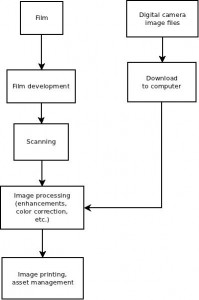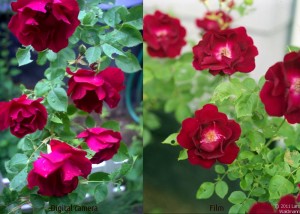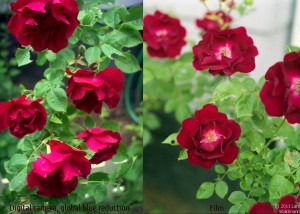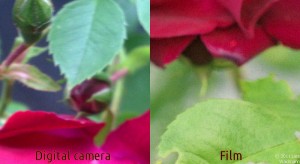Recently I came across some photography technique books from 2004-2006, which I enjoyed because film and digital photography were given equal space and considered equal media. This was the time when a lot of professional photographers switched to digital photography, because the new medium was seen as mature enough. In books before this time, film photography usually is given more weight, whereas books after this time focus solely on digital photography.
I still use film on a regular basis, but of course enjoy digital photograph as well for other purposes. I have used more and more film after using digital photography for a couple of years, because film still adds certain qualities to my work that I like (this is my way of not saying “digital is better than film” or vice versa). I will write some other time for which situations I prefer digital photography, and for which film photography is better suited in my opinion.
Younger generations of photographers have never used film. In my experience, using film does enhance photographic awareness and leads to a more contemplative style. When I shoot film, I take more time composing photos, whereas with digital photography I shoot quick bursts of images that take me a while later on the computer to sort out (which of the four very similar compositions do I like the best?). Specific reasons why I think film photography is still important and will not disappear are:
- Film photography equipment is VERY inexpensive. – With the “digital revolution” going on, people are abandoning their trusted film cameras for new digital equipment, which has led to very inexpensive prices for all types of film gear. Now is the time to use the film camera that was not affordable 15-20 years ago. If I don’t buy equipment from eBay, my favorite store is KEH. The quality of their equipment and the prices are outstanding. There is a huge supply of inexpensive film equipment and lenses available.
- Film integrates perfectly into a digital workflow. – While film requires chemical processing of some sort to make the photographs visible, it is relatively easy to scan film afterwards and use the photographs in the same way as digital camera files. It is also a possibility to get scans of film done in a photo lab at the time of development. In the next couple of weeks I will post some tutorials on the different steps. Some of us may already have a film scanner, because many flatbed scanners come with a transparency adapter for film scanning and the results can be very good. Of course a dedicated film scanner can usually produce better results. The following diagram compares the workflow of film and digital photography:
 After scanning of film, we have a digital file that is equivalent to an image file produced with a digital camera. The same possibilities exist once the film has been scanned. By the way, I would keep the scanned film, just in case better scanning technology becomes affordable.
After scanning of film, we have a digital file that is equivalent to an image file produced with a digital camera. The same possibilities exist once the film has been scanned. By the way, I would keep the scanned film, just in case better scanning technology becomes affordable. - Film renders color differently than a digital sensor. – In a digital sensor, we have an array of photosensors (i.e. for a 6 million pixel sensor (6 MP), the dimensions of the array would be 3000 x 2000 pixel). The photosensors by itself do not “see” color, which is why each is coated with a color filter, either R(ed), G(reen), or B(lue). About half of all photosensors are green-sensitive, the rest is equally divided between red and blue. The arrangement follows the so-called Bayer pattern. In the example of the 6 MP sensor, in the end the recorded image will give us a pixel at each position that has a color value for all three colors, which means that the missing two color values are interpolated from neighboring pixels. As we all know, the results of this process are very good. Film, in contrast, has a layered structure. The C(yan), M(agenta), and Y(ellow) layers are stacked on top of each other. Dyes is each layer act as color filters and later react during the development process to form permanent dyes. As you may have noticed, film follows the CMY color model, which is complementary colors to RGB. In reality I have noticed differences in the color rendition of film and digital photography. The photo of a rose bush was taken with a digital camera (left) and film (right). While I like the digitally recorded photo, I prefer the photograph recorded on film, because the colors just seem to be more life-like in my opinion. The digitally recorded photo has a little bit too much blue for my taste.

Since blue was to strong in the digital camera image, let us reduce blue globally and see what we get:

Now the results are a lot better than in the above image, but for my taste the colors still look cleaner in the film image. If I had only gotten the digital camera image, I would have been happy, just in comparison I think the film image looks more life-like. - Medium and large format film is the affordable high resolution option for low budget shooters. – The highest resolution sensors available at the moment are for medium format camera bodies and produce up to 80 MP files and at the time of this writing cost approximately $40,000. For most people, including a good portion of professional photographers, this is not affordable. Medium and large format film gear on the other hand is very affordable. The larger than 35 mm film size provides the option for detail-enriched, high resolution scans. Medium format film size is either 6×4.5 cm, 6×6 cm, 6×7 cm, or 6×9 cam, depending on the camera used. The Mamiya M645 system I use uses the 6×4.5 cm film format. The actual recorded film size is 56×42 mm (approx. 2.20×1.65 in). While flatbed scanners have very high resolutions, for the following calculation of pixel dimensions I assume a relatively conservative resolution of 2400 dpi (dots per inch). A scanned file has the approximate dimensions of 2.2o in x 2400 dpi = 5280 pixels on the long side, and 1.65 in x 2400 dpi = 3960 pixels on the short side. Multiplication of 5280×3960 tells us the total amount of pixels, which is 20,908,800 pixels, or about 21 MP. An increase of the scanner resolution to 3600 dpi or 4800 dpi leads to even larger files. A digital camera with a comparable resolution is still very expensive. Another difference is that a film or flatbed scanner actually scans all three colors, whereas a digital camera has to interpolate two colors per photo site (see above).
- Film grain provides pseudo detail that is very pleasing to the eye. – Within digital images we all had to get used to the appearance of digital noise, which comes in two “flavors”: luminance noise affects all three color channels and results in loss of detail and artifacts showing, whereas chrominance noise results in the appearance of single speckles of color in otherwise uniform areas of color. Film shows a different “noise” characteristic. With a higher ISO film, the silver halide crystals need to be larger to lead to higher light sensitivity. At sufficient magnification, the intrinsic structure of film becomes apparent as grain. Grain oftentimes creates the illusion of detail. The photo posted here compares digital camera noise (left) and film grain (right). Film grain creates a texture that is more in flow with the image, whereas digital camera noise appears more disruptive to the image. Some of that perception may have to do with our experience that film has been the recording medium of choice for so long. Fortunately there is software out there to mitigate the appearance of digital camera noise and film grain. Because of the pseudo-detail structure of film, film image sometimes appear to be sharper than comparable digital camera files.

- Today’s films are designed to be scanned. – In the past, companies like Kodak sold variations of similar film with slightly different characteristics such as color saturation and contrast. We have already and will continue to see the number of films declining, because manufacturers streamline their lines of film to just one variation. A recent examples for this is the Kodak Portra color negative line. Kodak used to sell Portra NC for medium contrast and medium color saturation, and Portra VC for higher contrast and color saturation. With digital imaging, the need for different film response curves has vanished, because digital imaging software lets us fine tune these parameters to one’s preferences. You may wonder what happens to film people have developed and printed in drug stores (one hour photo labs) – purely optical enlargers have completely disappeared. Most stores use Fuji Frontier or Noritsu systems. Color negative film is processed in a standard C-41 process, and then the film is scanned afterwards in a high speed scanner. A quick image enhancement is applied to the scanned files and then prints are produced on a photographic printer that exposes the image onto photographic paper using LEDs or lasers. The exposed photo paper is then processed in a wet chemistry process (RA-4). This is why drug stores can accept digital camera files, it actually saves them from having to process and scan film.
- Film scanning and photo printing technology is mature and quick. – About 10 years ago a company called “Applied Science Fiction” (ASF, no kidding) developed a system to eliminate scratches and dust during scanning of film. Kodak bought the company. The system is known as ICE3 or ICE4, depending on the iteration used. To eliminate dust and scratches, the film image is scanned with an infrared light source, which shows the defects in the film. An algorithm is then used to patch the defects. The results are typically very good. A lot of relatively inexpensive scanners utilize this system. Now there are also even faster systems available that use which utilize a dedicated digital camera to record an image of the film. Inkjet printing technology has mature significantly over the last couple of years. Ten years ago, I needed a six color inkjet printer to achieve photo quality results. Printed b/w was very difficult, and the results very poor. Nowadays even four color inkjet printers can produce photo quality results, while at the same time the printing speed is amazingly fast compared to the earlier printers. For b/w printing, the more expensive printers have grey inks. A less expensive alternative is to dedicate an inexpensive four color inkjet printer to b/w printing by replacing the standard inks with a grey set of inks.
Photographic materials available today provide us with unlimited possibilities, no matter whether film or digital photography is utilized. Both recording media have their place. In the end, it is information that is recorded, whether on a digital sensor or film. It is a great time to be involved in photography, because we have so many options and materials available.
Thank you for reading!

Deep thought! Thanks for cotgnibutinr.
Pingback: Photography: when to use film or digital | Kim & Lars Waldmann